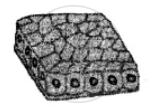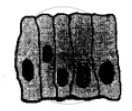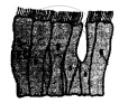Advertisements
Advertisements
Question
Write the name of the following tissue.
Tissue lining the inner surface of the mouth.
Solution
Squamous epithelium tissue
APPEARS IN
RELATED QUESTIONS
Describe various types of epithelial tissues with the help of labelled diagrams
Distinguish between Simple epithelium and compound epithelium
Based on the following information, identify the three types of epithelial tissue in the figures given below :
| a |  |
b |  |
c |  |
(1) Cuboidal epithelium: It consists of a single layer of cuboidal cells.
(2) Columnar epithelium: It is composed of tall, cylindrical cells with oval nuclei usually placed at the base of the cells.
(3) Ciliated epithelium: It consists of cells being hair-like cilia on their free surface.
The following statement is wrong. Rewrite it correctly by changing either one or two words.
Glandular epithelium is present in kidneys.
How many types of epithelial tissues have you studied? Write their functions.
Name the tissues found
at the outer layer of skin.
Name the tissues found:
in the testes and ovaries.
Answer the following question.
Describe different types of cell junctions.
Lining of small intestine is made up of ______.
The ciliated epithelium lines the______.
Prevention of substances from leaking across the tissue is provided by ______.
A long tree has several branches. The tissue that helps in the side ways conduction of water in the branches is
Write true (T) or false (F)
Epithelial layer is permeable layer.
An epithelial layer does not allow the regulation of materials between the body and the external environment.
Glandular epithelium gives a stratified appearance.
Write one point of difference between
Simple and compound epithelial tissue.
Identify the following relationship
Cuboidal: Epithelial
Cardiac: ______
Granulocytes: ______
Osteocytes: ______
Epithelium founds in the lining of stomach and intestine is
Write the appropriate type of tissues in column B according to the functions mentioned in column A.
| Column A | Column B |
| a. Secretion and absorption | i. ______ |
| b. Protective covering | ii. ______ |
| c. Linking and supporting framework | iii. ______ |
Classify and describe epithelial tissue on the basis of structural modifications of cells.
